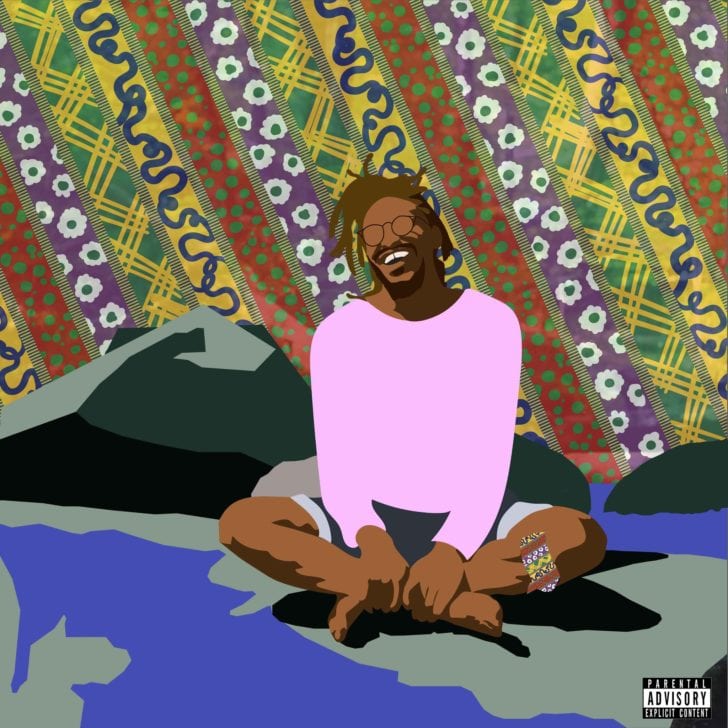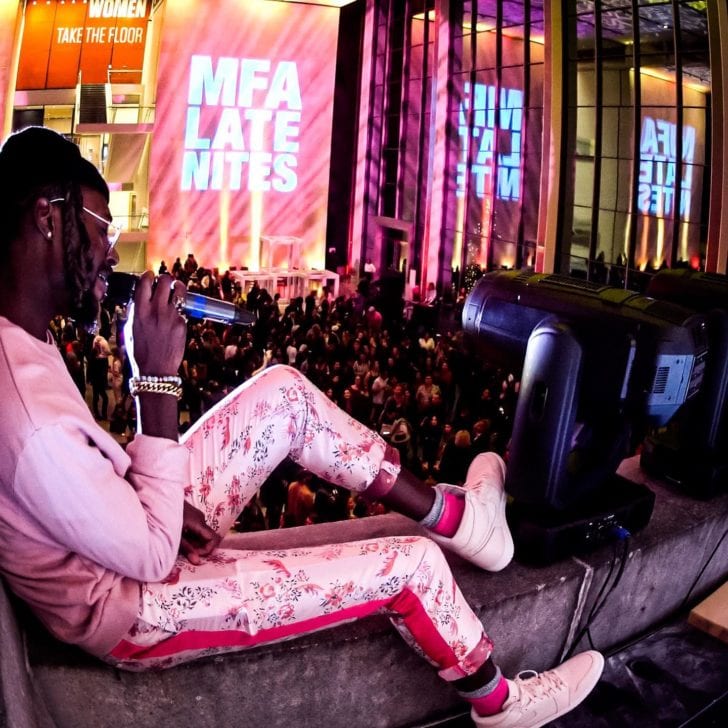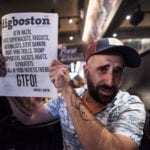
When I had the following cell phone exchange with Cliff Notez, the multidimensional master was just hours away from opening for Bad Rabbits at the Sinclair.
As you read this, he is about to—or just recently did, depending on when you check out the issue—help ring in 2020 with STL GLD and Latrell James at Oberon.
Next week, starting on Jan 11 and continuing through Feb 9, Notez will present “Into the Wiild: Answering Why the Wild Things Are,” a multimedia gallery exhibition at the Dorchester Art Project expanding on his album of that name.
We consider Notez to be one of the foremost renaissance talents around here who is using their own gifts and gusto to broaden opportunities for others as well. So while we covered the release of his last LP, Why the Wild Things Are, last September, we also wanted to connect with him for our What’s Right With Boston issue, since initiatives like his upcoming show are the kind of group effort the Hub needs, now and always. An “immersive dive into imaginary world created by our protagonist, Leon, as they confront their repressed emotions of anger, frustration, anxiety, and depression,” the month-long spectacle will feature “performances from local artists, screenings and workshops of films addressing the relative content of the show, guest lectures, and gallery tours.”
Notez was kind enough to let us interrupt his watching of Rick and Morty to answer our questions about this latest unique endeavor.
One of the reasons it is great to follow you is that it’s never the same. But doing something different every time you come out must be a huge pain in the ass. How and when did you decide that you weren’t going to just be another artist doing sets? Or doing shows? Was there some kind of a realization? Did you used to be the kind of artist who just came out and did a set here and there?
I think it’s always been in my nature, ever since I started being associated with art. I was a very, very hyperactive kid, and my mother just didn’t know what to do with me, and my dad didn’t know either. So they just put me in every single program that you can think of—anything from film classes, to ballet, to choir, to anything at all. They had no idea that I would try and make it a career; they were just trying to keep me busy. But I liked all of it—I found the joy in every single thing, and as I grew older, it was a way to stay sane. I see a lot of people who are just musicians, and they will come into something that every musician comes into—writer’s block—and it’s like, I don’t know what to do. When I come across writer’s block, I’m like, I guess I’m not a musician right now, let me go and do something else, whether it’s watching a movie, painting, or watching Rick and Morty.

As far as shows, when it got to the point where you had enough material and were sometimes going to headline, so to speak, how did you go about assembling things in an interesting way? You have all these wide-ranging interests, but how did you go about synthesizing them?
I never really see music as just a musical thing. YouTube is an amazing thing—I’ve seen some amazing shows that I have never really been at. Today I have a show at the Sinclair, and every time I have a show I will spend the day [leading up to it] just watching performances. Today I was watching Arcade Fire at Madison Square Garden in 2010, and an old Bon Iver performance. Also, when I was a writer back in 2013 or 2014, I was going to a lot of shows, and people would incorporate different elements into their live sets. And it’s also a big defense mechanism, like, I don’t want all of the attention on me. Let me find out what else people can be engaged with. Whether it’s a set design, or projections.
After performing for a couple of years, you start to see how audiences respond to certain sections of songs, and that moment when eyes roll back, so you want to make music that continues to engage people but still serves what I want to do as a whole.
It’s also that before this, the only job I ever had was at the ICA, and seeing the leading contemporary artists in the world do mind-blowing shit every day changed my thought process about how to really engage people.
When you were working there, before you made a name for yourself, how and when did you decide that you wanted to be an artist and performer in those kinds of settings instead of just working there?
My first half year working at the ICA, I was really just sprung off the fact that I got my first job working in a staff position at this really renowned museum. After that wore off, I was seeing these artists, and even though I was blown away by a lot of them, I thought that I might be as talented as some of these people, you never know. After that six-month period, I just shifted my thinking to How can I make this beneficial for me moving forward? Everything that I took in was only to learn how to grow. My main role at the ICA was as an educator, so I was working directly with the curators and the artists to educate high school students through all the different mediums—film, music production, everything that I do now. I needed to master these things, and these exhibits, so I could give it back. And then it was about figuring out how I could incorporate it into my own world.
Our goal at the ICA was to get students more acclimated, and I took that as me also getting more acclimated to where I can see myself in these spaces now.
Is there too much credit given to the city and the scene for stuff that certain individuals have been doing? Like you landing a series at Atwood’s in Cambridge last year? Can you say a word about finding the right alternative spaces, and about how those roads sometimes lead back to spots like the Sinclair?
Finding spaces began with looking for spaces that I enjoy. My mentality, and the way I go about these things, is rooted in that subconscious doubt of myself, in the sense that when I go to these things I’m like, Hmm, I don’t know if I can see myself here, but I can see these other dope artists here and me.
I guess that would be a good cue to talk about HipStory. For starters, how do you pronounce it?
It depends on the day. It’s your own thing—however you feel about it. We’re a digital media production company, and so we have our studio space in Cambridge and we’re working on one in JP as well. We can create digital content, and the experience as well, which is where we really got into event curation. We also highlight content that the community is creating, because I don’t think that the content we create is enough. There’s a lot more to be exposed and seen.

With Why the Wild Things Are, which came out a whole two years after your first album, how long did it take to put such an intimate project together? And now that people have had time to marinate with it for a couple of months, what’s it going to be like to share these visuals created by you and other artists? What should people expect at Dorchester Art Project?
It started when I first solidified the idea of the album title and I was half done with painting the album cover. I knew that every song had a narrative; my first album was like that, but it wasn’t as linear in storytelling as I wanted it to be. At the same time, I didn’t want to throw it all in people’s faces in the length of the album. Instead of painting out this whole script, I wanted to be as loose with it as I wanted to, and just give people a bunch of hits and let them figure it out. I was also creating fast and in this very secretive way. I had everybody on the album sign NDAs, so nobody was talking about what we were doing for a while. I knew that I was going through a lot of drama and a lot of pain that was seen as good; people would see me on the streets and congratulate me, and I would be like, I don’t even want to be here today.
What’s it like to share such an intimate experience with so many other artists?
The whole NDA thing was less about people leaking my shit and more about us living in this hyperattentive world where everything is so publicized, and we forget that some things are personal between specific people. That’s what I wanted, especially because I was talking about things that I didn’t even know I wanted to be talking about. I didn’t even know this album was going to be coming out. I just knew I wanted to make it, and then see if I wanted to share it with the world. When we were in the studio, it was just for us. That allowed us to be as honest as possible. When we’re living for our Twitter followers, we’re not being as honest. I wanted to be connected with the people in that studio.
I knew that the best way to do it and debrief it would be to do this project that had all these layers—not only for other people to figure out, but mostly for myself, so I can look back and say, Oh, that’s what I was feeling. That makes sense.
I know this is an annoying question, but what’s next?
I think about it, and the way that these two first projects came about, I can’t remember. The first one definitely came out during a smoke session after a HipStory meeting. With the second one, I was having a real problem with the word wild, and I wanted to reclaim it.
I don’t know what the third one is going to be. It might honestly be me starting a whole new band under another name. At the same time, I just see this as another project. We’re already working on different films, and other things that have been in the works for years. Maybe I don’t even put out an album for another couple of years, or ever again.
INTO THE WIILD AT DORCHESTER ART PROJECT, 1486 DORCHESTER AVE., BOSTON. 1.11–2.9. MORE INFO AT FACEBOOK.COM/THEHIPSTORY.
A Queens, NY native who came to New England in 2004 to earn his MA in journalism at Boston University, Chris Faraone is the editor and co-publisher of DigBoston and a co-founder of the Boston Institute for Nonprofit Journalism. He has published several books including 99 Nights with the 99 Percent, and has written liner notes for hip-hop gods including Cypress Hill, Pete Rock, Nas, and various members of the Wu-Tang Clan.

